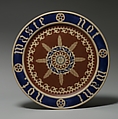Bread plate
Augustus Welby Northmore Pugin British
Factory Minton(s) British
This shallow dish raised on a short foot is made in the encaustic process, an "inlay" technique of filling a stamped or recessed design with a contrasting colored clay or slip. The inscription on the rim in pseudo-Gothic lettering reads: "Waste Not Want Not." Pugin made two versions of this tazza, the first with four colors and the second with six. The first version was exhibited at the 1849 Exhibition of British Manufacturers in Birmingham. Pugin believed that objects made with moral intentions would transfer these to the user, thereby promoting a more wholesome existence. The motto also reflected the agricultural and economic problems of England's "hungry forties."
Augustus Welby Northmore Pugin (1812–1852) was the first architect/designer to link a specific style to morals, godliness, and social values. He believed that manufacturers should be truthful in their use of materials; that wood should look like wood instead of being painted to look like marble. This tenet of truth to materials was the crux of the Arts and Crafts movement. Pugin also believed that deceptive construction was inherent to the classical style, whereas honest construction was in accord with the Gothic. Pugin, with the architect Charles Barry, received the commission to rebuild the Houses of Parliament in the Gothic style following a fire in 1834. He designed the interior decoration in the same style, sparking the Gothic Revival in England. Pugin also designed domestic and ecclesiastical objects in ceramic, precious metals, and wood, all in the Gothic style.
#418. Christopher Dresser and the Birth of Industrial Design
Due to rights restrictions, this image cannot be enlarged, viewed at full screen, or downloaded.

